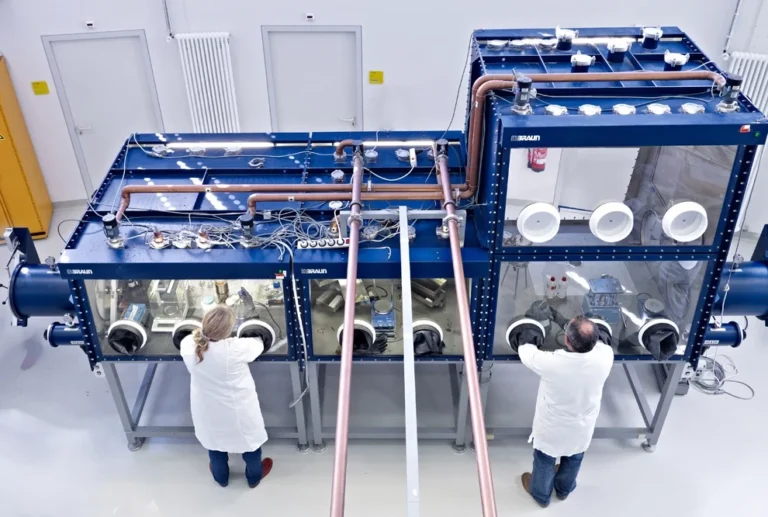Introduction to the Glove Box
A glove box is a sealed container designed to create a controlled environment where an operator can manipulate materials without direct exposure. It has glove ports that allow users to reach inside and handle objects while maintaining an isolated space. Glove boxes are essential in fields such as chemistry, pharmaceuticals, and even electronics manufacturing,
History and Evolution of the Glove Box
The glove box concept dates back centuries, initially used for isolating hazardous materials from human contact. The first primitive glove boxes were made from simple wooden or metal frames with flexible coverings, enabling people to work with sensitive materials without exposure to outside contaminants.
Types of Glove Boxes
Inert Gas Glove Boxes
Inert gas glove boxes are used in environments where reactive materials need to be protected from air or moisture. These boxes are filled with gases like nitrogen or argon to maintain an inert atmosphere, preventing chemical reactions.
Isolation Glove Boxes
These are designed for complete isolation to protect both the operator and the materials being handled. Isolation glove boxes are often used in biological research or pharmaceutical production to ensure that neither the operator is exposed to hazardous substances nor the materials are contaminated.
Key Components of a Glove Box
Glove boxes, regardless of their type, share common components:
- Main Chamber: This is the sealed environment where the work takes place. It can be filled with gases or maintained under a vacuum, depending on the need.
- Glove Ports and Gloves: These are crucial parts that allow the user to manipulate materials within the box. Gloves must be flexible, durable, and provide a tight seal.
- Viewing Windows: Transparent panels, often made of tempered glass or acrylic, allow the operator to see inside the box without compromising the sealed environment.
- Antechamber (Airlock): This small chamber is used to introduce or remove objects from the glove box without disturbing the controlled environment within the main chamber.
How Does a Glove Box Work?
Glove boxes maintain a controlled environment through gas purging or vacuum sealing. For inert gas glove boxes, gases like nitrogen or argon are pumped in, replacing air and creating an oxygen-free environment. In a vacuum glove box, the air is completely removed, allowing experiments and procedures to occur without any atmospheric interference.
Uses of Glove Boxes in Science and Industry
Glove Boxes in Chemistry Labs
Chemistry labs often use glove boxes to conduct experiments with materials sensitive to air or moisture. For instance, certain metals and compounds can react explosively when exposed to air, making a glove box crucial for safety.
Glove Boxes in the Pharmaceutical Industry
In pharmaceutical production, glove boxes ensure that sterile environments are maintained. This prevents contamination of drugs, ensuring that medicines are produced in safe and controlled conditions.
Materials Used in Manufacturing Glove Boxes
Glove boxes are constructed from durable, non-reactive materials such as stainless steel or tough polymers. The materials must withstand the gases, chemicals, or pressure differences within the box.
Maintenance and Safety Considerations for Glove Boxes
Glove boxes need regular maintenance to remain effective. This includes cleaning the interior to prevent contamination, regularly checking seals, and ensuring that the gloves are intact without leaks. Following safety protocols, such as wearing additional protective gear, is essential when handling hazardous materials.
Innovations in Glove Box Technology
Technological advancements have improved glove box safety and functionality. Modern glove boxes include sensors to monitor gas levels, automated purging systems,.
Conclusion
The glove box is an indispensable tool across many industries, providing safety, precision, and control when working with sensitive or hazardous materials. Its wide-ranging applications, from pharmaceuticals to nuclear science, demonstrate its versatility and importance in ensuring safe and effective work environments.
FAQs
- What is the purpose of a glove box in a laboratory setting?
A glove box is used to create a controlled environment for handling sensitive materials, protecting both the operator and the materials from contamination or exposure. - How do you maintain a glove box?
Regular cleaning, inspecting seals, and checking the integrity of gloves are crucial maintenance steps for ensuring a glove box remains safe and functional. - Can a glove box be used in the food industry?
Yes, glove boxes can be used in food production when sterile or controlled environments are needed, although they are more commonly used in scientific and industrial settings. - What are the safety precautions when using a glove box?
Wear additional protective gear, check the integrity of the gloves, and ensure the environment inside the glove box is properly maintained (e.g., gas levels in an inert glove box). - How is a glove box different from a fume hood?
A glove box provides a sealed environment to isolate materials, while a fume hood ventilates harmful fumes to protect the operator from inhalation but doesn’t isolate the materials completely.


